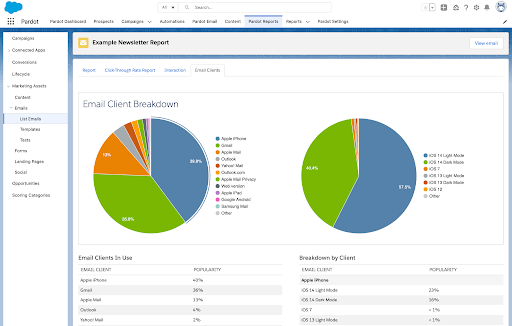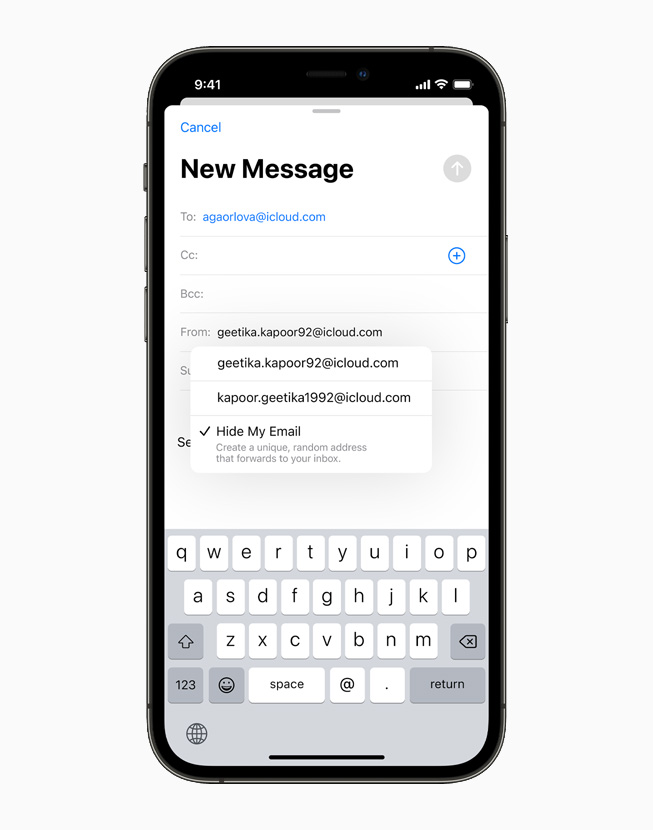In September 2021, Apple privacy changes will start having a big impact on Pardot email marketing reporting metrics. Are you ready to pivot your reporting strategy in response to the changes?
Apple announced some big, new privacy changes in June, and that’s what sparked the changes in email marketing reporting metrics. These changes are included with the Apple software update to iOS 15, iPadOS 15, macOS Monterey, and iCloud.com.
One of these changes, Apple Mail Privacy Protection, is getting lots of attention in the marketing operations community. That’s because of the expected impact to the email open rate metric — a key performance indicator for most marketers. However, there are multiple new changes coming with the iOS update every Pardot professional should be aware of.
In this article, we’ll cover all three:
- Apple Mail Privacy Protection
- iCloud Private Relay
- Hide My Email
For each of these changes, we’ll share key features to be aware of plus how to get your org, team, and stakeholders ready. We know how hard these changes can be for your already-swamped team, so we’re here to help you through this.
Respecting Apple user privacy
Before we get started, I want to point something out. These changes are a huge win from the perspective of Apple and their users. By using this new software version, users can decrease the amount of data companies are collecting about their behavior and interests. This gives them more control over what information they share and when.
Our job as ethical marketing professionals is to do three things:
- Respect our users.
- Treat their data with integrity.
- Adapt to the ever-changing technology and regulatory landscape.
So, we’ll do our best to focus on the positive aspects of the changes by providing solutions to the challenges they present.
Apple Mail Privacy Protection
Marketers using Pardot set automations based on email opens because, typically, opening an email indicates that a prospect is interested in a product or service. But, the new Apple privacy changes will skew email open rates and make it more difficult to know when Apple users actually open an email.
Apple Mail Privacy Protection (MPP) has two key features:
- Open tracking prevention
- IP protection
Essentially, Apple iOS 15 opens the email and downloads the content when an email hits a prospect’s inbox. This prevents accurate open tracking because all emails going to Apple devices will appear to be opened in reporting metrics.
Apple also downloads the content through a series of proxy servers. This feature is obscuring the IP address of the email subscriber. As a result, Pardot can’t report on the user’s device and behavior accurately.
How to adjust your marketing strategy
The first thing you need to do is answer the question, “What proportion of your database uses an Apple email client?”
Here’s how to do that:
- Review some of your recent email sends.
- Go to Pardot Reports > List Emails > Email Clients (in Pardot Lightning)
- Add up the percentages in the “Popularity” column. This will give you a ballpark estimate of the potential impact.
Is it 10%, 25%, or 50%+ of your audience? The greater the proportion of your audience using an Apple email client, the less reliable your email open rate metrics will be after the iOS 15 update.

Conversely, the non-Apple portion of your audience provides a reliable segment for email open stats and future testing (personalization, A/B, etc.)
Questions to ask
Now that you understand the severity with which your data could be impacted, consider the following questions:
- Do you have any reports that include email open rate?
- Who views these reports?
- How can you proactively adjust these reports to decrease the importance of this metric?
- How can you communicate with your stakeholders so that they know that the open rate is no longer reliable?
Next, do a thorough review of your Pardot automations. This includes automation rules, engagement studio programs, completion actions, dynamic lists, scoring, etc. Do any of these run based on open rate? If so, develop a plan to leverage an alternative trigger like email click* or form submission.
*I put a big asterisk next to “email click,” as this metric has been endangered for a while. Email clicks can be caused by spam filters, so be cautious when using email click as a trigger on your automations or as a key metric in your reporting.
Ultimately, this change is a step in the right direction for marketing teams. There’s never been a better time to shift your focus from vanity metrics like open rate and click through rate to more meaningful campaign performance metrics like conversions and return on investment (ROI).
Apple iCloud Private Relay
The new iCloud Private Relay feature will be baked into iCloud. Launching as a “public beta,” this feature functions similar to a VPN, encrypting all traffic leaving a user’s device when browsing with Safari. Private Relay leverages data encryption and anonymous IP addresses that hide a user’s location and web browsing activity.
By hiding your specific IP address, Private Relay inhibits websites from building a profile based on your activity across multiple websites and selling your data to advertisers and data brokers.
This feature is limited to paid iCloud account users who browse with Safari and turn on the Private Relay feature. (All paid iCloud accounts will be automatically upgraded to iCloud+ as part of the update.)
iCloud Private Relay disconnects your IP address from your DNS request (website that you’re visiting), which is great news to those seeking ultimate privacy and not wanting their activity information to be sold to advertisers. Unfortunately, it also disconnects website tracking that Pardot users have in place. With temporary IP addresses assigned, website activity will be difficult to associate to a known prospect.
This capability does not hide the prospect’s geography. That means you can still track prospect regions, and IP addresses can be identified as proxy servers.
Apple Hide My Email

The last change to know about is Hide My Email. This update allows iCloud subscribers to log into a website using a randomized email address that ties back to their iCloud account.
If your company allows public users to generate accounts or offers free trials, you could encounter a scenario in which a user takes advantage of Hide My Email to acquire multiple free trials.
Hide My Email is also another challenging feature for Pardot users. That’s because it is once again disconnecting essential data (a prospect’s real email address) from website activity tracking.
This functionality will impact open rate statistics. That means you will have to shift to other metrics such as click-through rate. It will also affect marketers who use email open rates for retargeting, and those who use email open rate as a varying factor for dynamic content. So you’ll have to pivot those strategies if you’re currently using email open rates for retargeting or dynamic content variations.
Focus on reporting metrics that matter most
It’s normal to fear what we don’t understand. And these new privacy changes may seem scary without knowing why they’re actually good news.
All of these privacy changes will impact marketing as a whole, making it harder and harder to track email activity and then associate it with activity in other channels. It is also an opportunity for marketers to take a fresh look at current strategies and craft new ways to put prospects in control.
Here are suggestions to address the changes and adjust your marketing strategy:
- Update your Email Preference Center to offer subscribers greater insight into the topics they already interact with and other topics that are available.
- Seek ways to connect email clicks with omnichannel metrics that demonstrate customer engagement. This includes:
- Offline purchases
- Account activity
- Website visits
- Mobile app activity
- SMS engagement
- Explore using link clicks, external activity such as webinar registrations, and other engagement signals instead of email opens as more accurate interest indicators.
- Find ways to understand the sentiment of an email message, perhaps with a thumbs up/down action or NPS-type of question within an email.
- Look for opportunities to link your marketing channels (email, website, social, etc.), and get the cross-connection data flowing.
iCloud Private Relay and Hide My Email — on top of third-party/first-party tracking cookie changes already afoot — necessitate creative thinking to make prospect activity connections that were once seamless.
Prospect privacy is paramount
These three Apple privacy changes are going to affect the way you currently work in Pardot. But that’s a good thing. Your prospects have more autonomy when interacting with your company through email and your website. All you have to do is adjust your strategy so you can focus on metrics that matter most rather than vanity ones.
Now that you’re better equipped to prepare for the Apple iOS 15 updates, it’s time to formulate your game plan and switch up your marketing strategy to evolve with the changes.
You can always reach out to the team at Sercante for support while navigating it all.
Thank you to Pam Carey and Joy Alphanso for contributing to this post.









